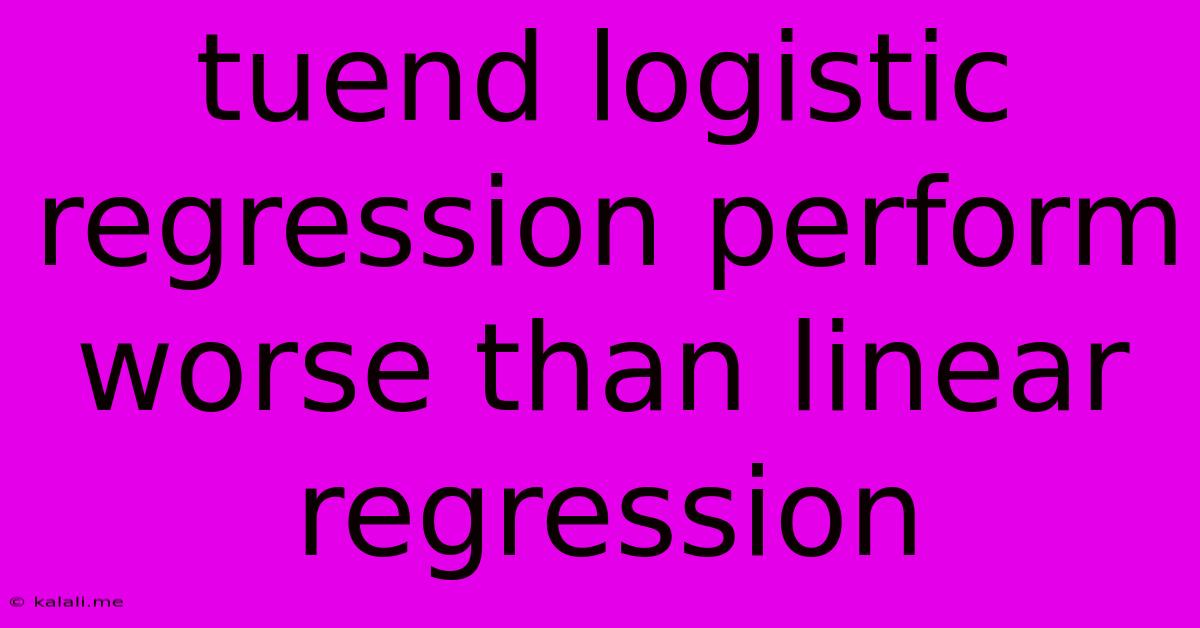Tuend Logistic Regression Perform Worse Than Linear Regression
Kalali
May 23, 2025 · 3 min read

Table of Contents
When Logistic Regression Underperforms: Understanding its Limitations Compared to Linear Regression
Logistic regression, a powerful tool for classification problems, sometimes yields worse results than linear regression, a method designed for regression tasks. This seemingly counterintuitive outcome arises from the fundamental differences between these models and the specific characteristics of the dataset. This article delves into the scenarios where logistic regression might underperform, explaining the reasons behind it and offering potential solutions.
Understanding the Core Differences:
Before diving into the reasons for underperformance, let's briefly recap the core differences between linear and logistic regression. Linear regression predicts a continuous dependent variable, while logistic regression predicts the probability of a categorical dependent variable (usually binary – 0 or 1). Linear regression models a linear relationship between the independent and dependent variables, while logistic regression uses a sigmoid function to transform the linear relationship into a probability between 0 and 1.
Situations Where Logistic Regression Might Falter:
Several situations can lead to logistic regression performing worse than linear regression, even when a classification task seems appropriate:
-
Highly Overlapping Classes: If the classes in your dataset are significantly overlapping, meaning there's a substantial amount of data points with features that blur the lines between classes, logistic regression might struggle to accurately classify them. Linear regression, while not ideal for classification, may provide a better approximation of the underlying trend, particularly if the goal is to predict a continuous "likelihood" rather than a strict binary classification.
-
Non-linear Relationships: Logistic regression fundamentally assumes a linear relationship between the independent and dependent variables after the sigmoid transformation. If the relationship is significantly non-linear, logistic regression might misinterpret the data, leading to poor performance. Linear regression can sometimes capture non-linear trends more effectively, particularly if transformed variables or non-linear models are incorporated.
-
Imbalanced Datasets: In datasets with a highly imbalanced class distribution (e.g., 90% class 0, 10% class 1), logistic regression can become biased towards the majority class. While techniques like oversampling or undersampling can mitigate this, in some cases, linear regression might offer a more balanced prediction, although it won't produce probabilistic classification directly. A post-processing step might be needed to convert the linear regression output into classes.
-
Inappropriate Evaluation Metrics: Using inappropriate evaluation metrics can mask the true performance of logistic regression. For example, using accuracy as the sole metric on an imbalanced dataset can be misleading. Precision, recall, F1-score, and the area under the ROC curve (AUC) provide a more comprehensive evaluation and might reveal the limitations of logistic regression even when seemingly high accuracy is reported.
-
Incorrect Feature Scaling: Like many machine learning algorithms, logistic regression is sensitive to feature scaling. Features with vastly different ranges can dominate the model, hindering its performance. Proper standardization or normalization is crucial for logistic regression, and failure to do so could contribute to its underperformance. Linear regression also benefits from feature scaling but may be slightly less sensitive depending on the implementation and optimization algorithm.
Addressing the Underperformance:
If logistic regression underperforms, consider the following actions:
-
Data Preprocessing: Carefully examine your data for outliers, missing values, and the presence of multicollinearity. Addressing these issues can significantly improve the performance of both linear and logistic regression.
-
Feature Engineering: Create new features derived from existing ones that might better capture the underlying patterns and relationships within the data. This can be particularly helpful in situations with non-linear relationships.
-
Model Selection: Explore alternative models more appropriate for your data, such as support vector machines (SVM), decision trees, or even a simple k-nearest neighbors (k-NN) classifier.
-
Regularization: Techniques like L1 and L2 regularization can help prevent overfitting, especially in high-dimensional data, leading to better generalization and performance.
Conclusion:
While logistic regression is a powerful classification tool, it's not universally superior. Understanding its limitations and the situations where linear regression might unexpectedly perform better is crucial for effective model selection and deployment. A thorough data analysis, careful model evaluation, and exploration of alternative models are key to achieving optimal results. Remember that choosing the "best" model always depends on the specific context of the problem and the goals of the analysis.
Latest Posts
Latest Posts
-
How Many Days Is In 11 Weeks
Jul 14, 2025
-
How Many Grams Are In One Tola Gold
Jul 14, 2025
-
How Many Oz In A Pound Of Freon
Jul 14, 2025
-
How Many Years Are In A Millennia
Jul 14, 2025
-
Words With C As The Second Letter
Jul 14, 2025
Related Post
Thank you for visiting our website which covers about Tuend Logistic Regression Perform Worse Than Linear Regression . We hope the information provided has been useful to you. Feel free to contact us if you have any questions or need further assistance. See you next time and don't miss to bookmark.